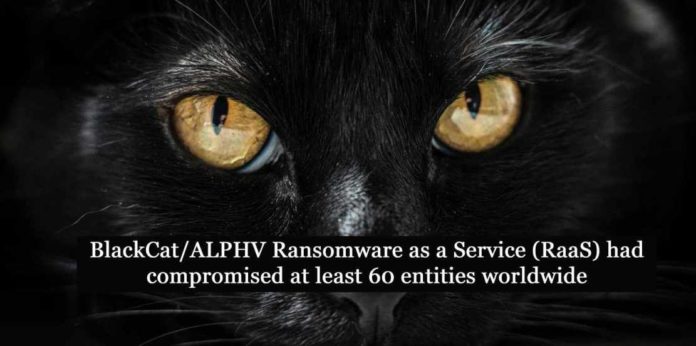The Federal Bureau of Investigation (FBI) says the BlackCat/ALPHV ransomware as a service (RaaS) had compromised at least 60 entities worldwide and is the first ransomware group to do so successfully using RUST, considered to be a more secure programming language that offers improved performance and reliable concurrent processing.
BlackCat-affiliated threat actors typically request ransom payments of several million dollars in Bitcoin and Monero but have accepted ransom payments below the initial ransom demand amount. Many of the developers and money launderers for BlackCat/ALPHV are linked to Darkside/Blackmatter, indicating they have extensive networks and experience with ransomware operations.
The FBI revealed this in a TLP: WHITE flash alert released on Wednesday in coordination with the Cybersecurity and Infrastructure Security Agency (DHS/CISA). The flash alert is part of a series of similar reports highlighting the tactics, techniques, and procedures (TTPs) used by and indicators of compromise (IOCs) linked to ransomware variants identified during FBI investigations.
Also Read: Espionage Group Continues to hit Ukraine with new malware variants
Technical Details:
BlackCat/ALPHV ransomware leverages previously compromised user credentials to gain initial access to the victim system. Once the malware establishes access, it compromises Active Directory user and administrator accounts. The malware uses Windows Task Scheduler to configure malicious Group Policy Objects (GPOs) to deploy ransomware. Initial deployment of the malware leverages PowerShell scripts, in conjunction with Cobalt Strike, and disables security features within the victim’s network.BlackCat/ALPHV ransomware also leverages Windows administrative tools and Microsoft Sysinternals tools during compromise.
Also Read: Xanpei Virus Infecting Normal Excel Files
BlackCat/ALPHV steals victim data prior to the execution of the ransomware, including from cloud providers where company or client data was stored.
The actors leverage Windows scripting to deploy ransomware and to compromise additional hosts. Forexample, the following batch and PowerShell scripts were observed:
- start.bat – launches the ransomware executable with required arguments
- est.bat – copies the ransomware to other locations
- drag-and-drop-target.bat – launches the ransomware executable for the MySQL Server
- run.bat – executes a callout command to an external server using SSH – file names may change depending on the company and systems affected
- Runs1.ps1 – PowerShell script to disable McAfee
Also Read: Soc Interview Questions and Answers – CYBER SECURITY ANALYST
Indicators of Compromise:
| Filename | MD5 Hash |
| amd – Copy.ps1 | 861738dd15eb7fb50568f0e39a69e107 |
| ipscan.ps1 | 9f60dd752e7692a2f5c758de4eab3e6f |
| Run1.ps1 | 09bc47d7bc5e40d40d9729cec5e39d73 |
| [###].ps1 | CME.ps1 |
| [#].ps1 | Run1.ps1 |
| mim.ps1 | [##].ps1 |
| psexec.ps1 | Systems.ps1 |
| System.ps1 |
| Filename | MD5 Hash |
| CheckVuln.bat | f5ef5142f044b94ac5010fd883c09aa7 |
| Create-share-RunAsAdmin.bat | 84e3b5fe3863d25bb72e25b10760e861 |
| LPE-Exploit-RunAsUser.bat | 9f2309285e8a8471fce7330fcade8619 |
| RCE-Exploit-RunAsUser.bat | 6c6c46bdac6713c94debbd454d34efd9 |
| est.bat | e7ee8ea6fb7530d1d904cdb2d9745899 |
| runav.bat | 815bb1b0c5f0f35f064c55a1b640fca5 |
| Filename | MD5 Hash |
| http_x64.exe | 6c2874169fdfb30846fe7ffe34635bdb |
| spider.dll | 20855475d20d252dda21287264a6d860 |
| spider_32.dll | 82db4c04f5dcda3bfcd75357adf98228 |
| powershell.dll | fcf3a6eeb9f836315954dae03459716d |
| rpcdump.exe | 91625f7f5d590534949ebe08cc728380 |
| Filename | SHA1 Hash |
| mimikatz.exe | d241df7b9d2ec0b8194751cd5ce153e27cc40fa4 |
| run.exe | 4831c1b113df21360ef68c450b5fca278d08fae2 |
| zakrep_plink.exe | fce13da5592e9e120777d82d27e06ed2b44918cf |
| beacon.exe | 3f85f03d33b9fe25bcfac611182da4ab7f06a442 |
| win1999.exe | 37178dfaccbc371a04133d26a55127cf4d4382f8 |
| [compromised company].exe | 1b2a30776df64fbd7299bd588e21573891dcecbe |
| test.exe | xxx.exe |
| Mim.exe | xxxw.exe |
| crackmapexec.exe | Services.exe |
| plink.exe | Systems.exe |
| PsExec64.exe |
Additional Observed Filenames
SHA256 Hashes:
| 731adcf2d7fb61a8335e23dbee2436249e5d5753977ec465754c6b699e9bf161 |
| f837f1cd60e9941aa60f7be50a8f2aaaac380f560db8ee001408f35c1b7a97cb |
| 731adcf2d7fb61a8335e23dbee2436249e5d5753977ec465754c6b699e9bf161 |
| 80dd44226f60ba5403745ba9d18490eb8ca12dbc9be0a317dd2b692ec041da28 |
C2 IPs:
89[.]44[.]9[.]243
142[.]234[.]157[.]246
45[.]134[.]20[.]66
185[.]220[.]102[.]253
37[.]120[.]238[.]58
152[.]89[.]247[.]207
198[.]144[.]121[.]93
89[.]163[.]252[.]230
45[.]153[.]160[.]140
23[.]106[.]223[.]97
139[.]60[.]161[.]161
146[.]0[.]77[.]15
94[.]232[.]41[.]155
Mitigations:
The FBI does not encourage paying ransoms. Payment does not guarantee files will be recovered. It may also embolden adversaries to target additional organizations, encourage other criminal actors to engage in the distribution of ransomware, and/or fund illicit activities.
Also Read: SystemBC Malware Being Used by Various Threat Attackers – Initial access to Indicator of Compromise
Regardless of whether you or your organization have decided to pay the ransom, the FBI urges you to promptly report ransomware incidents to your local FBI field office. Doing so provides the FBI with critical information needed to prevent future attacks by identifying and tracking ransomware attackers and holding them accountable under US law.
- Review domain controllers, servers, workstations, and active directories for new or unrecognized user accounts.
- Regularly back up data, air gap, and password protect backup copies offline. Ensure copies of critical data are not accessible for modification or deletion from the system where the data resides.
- Review Task Scheduler for unrecognized scheduled tasks. Additionally, manually review operating system defined or recognized scheduled tasks for unrecognized “actions” (for example: review the steps each scheduled task is expected to perform).
- Review antivirus logs for indications they were unexpectedly turned off.
Also Read: Detecting Office365 Azure AD Environment Backdoors
- Implement network segmentation.
- Require administrator credentials to install software.
- Implement a recovery plan to maintain and retain multiple copies of sensitive or proprietary data and servers in a physically separate, segmented, secure location (e.g., hard drive, storage device, the cloud).
- Install updates/patch operating systems, software, and firmware as soon as updates/patches are released.
- Use multifactor authentication where possible.
- Regularly change passwords to network systems and accounts, and avoid reusing passwords for different accounts.
- Implement the shortest acceptable timeframe for password changes.
- Disable unused remote access/Remote Desktop Protocol (RDP) ports and monitor remote access/RDP logs.
- Audit user accounts with administrative privileges and configure access controls with least privilege in mind.
- Install and regularly update antivirus and anti-malware software on all hosts.
- Only use secure networks and avoid using public Wi-Fi networks. Consider installing and using a virtual private network (VPN).
- Consider adding an email banner to emails received from outside your organization.
- Disable hyperlinks in received emails.
Source/Credits – FBI Internet Crime Complaint Center IC3



































